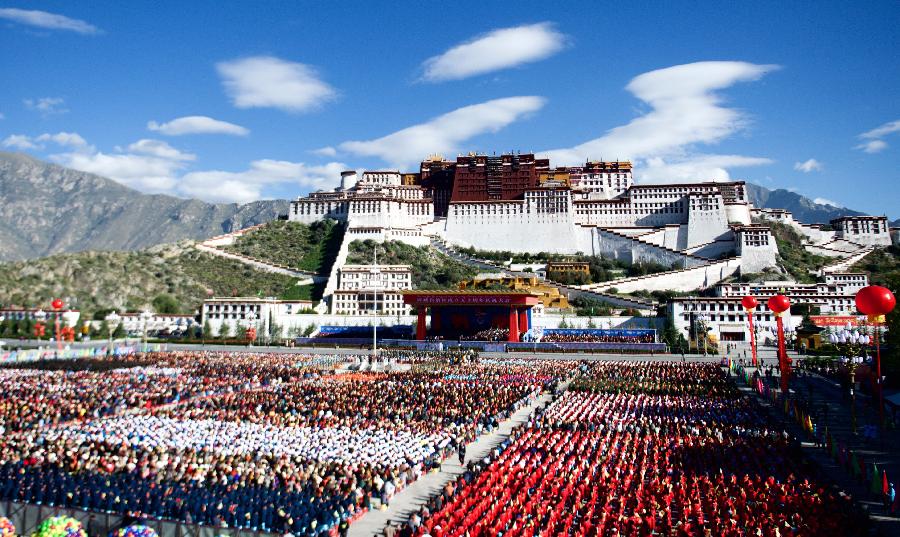
By Dr Satish Kumar*
(TibetanReview.net, Sep21, 2015) – “Tibet is now in its golden age,” says a white paper on Tibet titled “Successful Practice of Regional Ethnic Autonomy in Tibet” issued by China on September 6. This policy document was released to mark the 50th anniversary of the founding of the Tibet Autonomous Region (TAR). The document continues to criticise the Dalai Lama for his stand on the status of Tibet. He has been living in exile in India since 1959 when he fled his homeland with his followers. The white paper claims that the 14th Dalai Lama has constantly preached the “middle way,” peddled the concept of a “Greater Tibet,” and lobbied for “a high degree of autonomy” which ultimately aims at independence. “Obviously he violates the Constitution of China and its state system, and greatly damage the fundamental interests of all ethnic groups in Tibet, which is why they have met strong opposition from all Chinese people, including those of all ethnic groups in Tibet, and hence why they are doomed to fail,” so the white paper accuses the Dalai Lama.
On the other hand, China claims that the Tibetan culture and people have been much better off since its occupation rule began in 1959. It claims: “Tibet’s traditional culture is well protected and promoted, and freedom of religious belief in the Region is respected, while its ecological environment is protected, too”. The white paper also presents data to justify its rule over the last 50 years. It claims: Earlier Tibet did not have a single school in the modern sense; its illiteracy rate was as high as 95 percent among the young and the middle-aged; there was no modern medical service, and praying to the Buddha for succour was the main resort for most people if they fell ill; their average life expectancy was 35.5 year. Beijing compares these to the rapid development and modernization that has occurred in the past 60 years: In 2013, the Gross Domestic Product (GDP) of Tibet reached 80.767 billion yuan [$13 billion]; the per-capita net income of farmers and herdsmen was 6,578 yuan [$1,060] and the per-capita disposable income of urban dwellers was 20,023 yuan [$3,228]… In 2013, the population of Tibet rose to 3.1204 million, and average life expectancy was 68.2 years.
Even if the above data are true, there are many aspects of which are equally true. The Tibetan community has been butchered and subjugated to reduce them to slavery. Their twin identities of faith and pastoral lives were forcefully destroyed by the communist regime. Tibet was been strategically cut into two parts. One part of it, the Tibet Autonomous Regions, has been converted into a nuclear dustbin, spreading deadly diseases such as cancer. Thousands of Tibetans are behind the bar. Their economic status is very low. The policy of transferring Han Chinese into the TAR is making the Tibetans a minority community in their own region. There was further disappointment for Tibetans and supporters across the world at the beginning of 2015 when China announced plans to increase the Han-Chinese population of Tibet by 30 percent by 2020 — a total of approximately 280,000 new arrivals. This would strengthen China’s rule of terror and worsen the pace of the ongoing cultural genocide. China’s 60 year rule in Tibet has failed to win Tibetan hearts and minds under the umbrella of the so called “Peaceful Liberation of Tibet.” Besides, it has lost its international reputation and any remaining claim to moral leadership in this world by defending its failed iron fist policies in occupied Tibet.
Chinese Takeover of Tibet and Its Implications for India
The Chinese takeover of Tibet was a strategic move rather than for historical or ideological reasons. China has always been apprehensive of the influence of external powers in the territory of Tibet. That is why it purportedly shifted the area of buffer zone from Tibet to the tiny Himalayan states like Nepal and Bhutan. China’s Tibet policy impacts on Indian security interests in two ways. One, it exposed the border problem between India and China which led to the 1962 Sino-Bharat war. The Chinese invasion of Tibet ended the buffer zone between the two countries. It also increased China’s reach into South Asia.
Other serious consequences of Chinese developmental strategy in Tibet could be in terms of environmental hazards. India’s major rivers originate from the trans-Himalayan region. China’s western development programme is causing major deforestation and ecological imbalance. Tibet is endowed with the greatest river systems in the world. Its rivers supply fresh water to 85 per cent of Asia’s population.
China’s policies towards Bharat have been characterised as a judicious combination of deep strategy and surface diplomacy. The deep strategy consists of striving to gain a strategic edge over India in Inner Asia by courting India’s acceptance of the occupation of Tibet. At the same time China seeks strategic alliance with Pakistan to deny Bharat regional supremacy in South Asia.
The surface diplomacy aspect is characterised by frequent visits of all kinds to New Delhi since 1994. China plans to build a 540-kilometre strategic high-speed rail link between Tibet and Nepal, which could pass through a tunnel under Mt Everest. Such a move could raise alarm in India about the Communist giant’s growing influence in its neighbourhood.
“A proposed extension of the Qinghai-Tibet Railway to the China-Nepal border through Tibet would boost bilateral trade and tourism as there is currently no rail line linking the two countries,” reported China’s state-run China Daily reported today (Sept 11. The rail line is expected to be completed by 2020. However, there was no word on the cost of the project. The 1,956-km long Qinghai-Tibet railway already links the rest of China with the Tibetan capital Lhasa and beyond.
Reasons for the White Paper
This latest white paper is toughly worded and makes at least one important additional new demand on the Dalai Lama. It emphasizes, “Tibet has been an integral part of China since ancient times, and has never been an independent nation”. The stress on ‘antiquity’ is embedded in the text of the white paper which, in a departure from past white papers, makes a major alteration to the long-standing Chinese position on the Dalai Lama. It pushes China’s claim over Tibet back to the 7th century from the 12th century. Stating that there was a close connection between the Tibetan people and the Han and other ethnic groups, it says, “There has never been a break in economic, political and cultural exchanges between Tibet and the rest of China”. This statement has been rejected by the exile Tibetan government and the designated prime minster of Tibet at Dharamsala. “Tibet was an independent country, and Tibet is under occupation today,” said Lobsang Sangay, who was elected prime minister in 2011 by some 150,000 exiles after the Dalai Lama abdicated political duties in favour of focusing on his role as Tibetan Buddhism’s spiritual leader.
The scenario of world politics is changing. This change has certain degree of impacts on China’s forceful occupation of Tibet. One, despite its aggressive and militarised rule of Tibet, China has failed to change the mindset of the Tibetan communities. Their faith in their spiritual leader, His Holiness Dalai Lama, is rock-solid. Nevertheless, the aging Dalai Lama is now 80 years old. The Chinese scheme of imposing its own Panchen Lama, Tibet’s second post important religious leader, has completely failed.
If the Tibetan community refuses to accept the roadmap drawn up by the Communist Chinese regime during the period of the 14th Dalai Lama, it would be much more difficult after he is no more. And that is the reason why it seems to be in a hurry to look for a makeshift arrangement. Former Chinese president Jiang Zemin had accepted that any naming of Tibet’s spiritual leader will have an electrifying effect in Tibet.
Second, India has also informally changed its stand. During the period of Prime Minister Indira Gandhi, Bharat adopted twin tricks on Tibet. Officially it accepted Tibet as an integral part of China but supported the Tibet liberation movement from India. The current government appears to be tracking the same route. During celebrations marking the 80th birthday of the Dalai Lama, two of India’s cabinet ministers participated the ceremony in Dharamsala. Bharat is also seeking ways to challenge China’s obtrusive anti-Bharat activities in the South Asian region.
Third, America is already planning to contain China. The new regime in Russia under Putin is equally apprehensive of China’s rising power. In such a scenario, China is anxious to cement its tongue, once stated by Chairman Mao Tsetung to be protected by the jaw, namely Tibet, from external forces.
That is why China has come out with a white paper. The coming months and years will see the unfolding of fast-track changes in Tibet. Any legitimizing of the integration of Tibet is only possible during the tenure of the Dalai Lama. After he is no more, China won’t be able to coerce the Tibetans to unite with it. And there is every likelihood of the flaring up of the Tibetan movement both in and outside Tibet. This is heat under which China is acting, with the current president Xi Jinping being apparently in a hurry to address the developing situation.
* Dr Satish Kumar is the Head, Centre for International Relations, Central University of Jharkhand, Ranchi.



